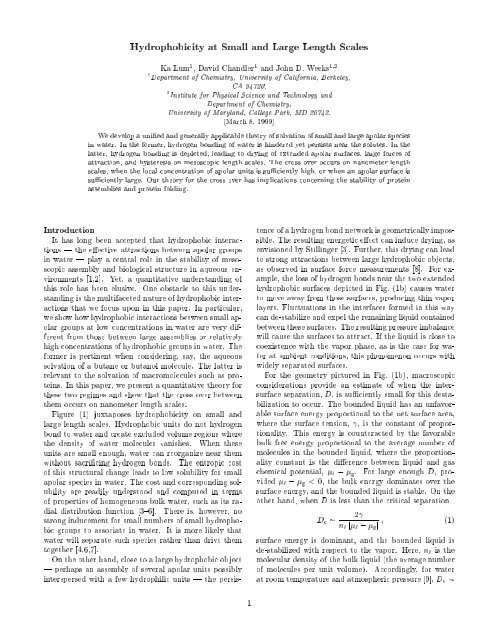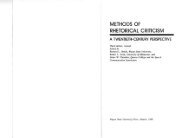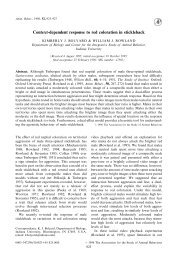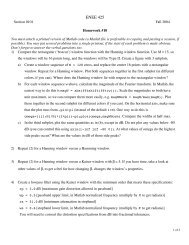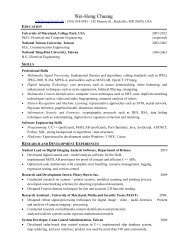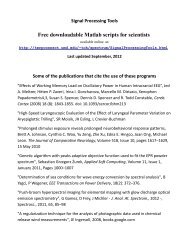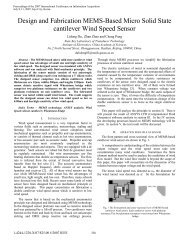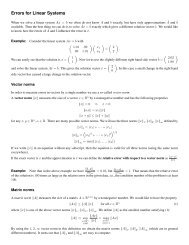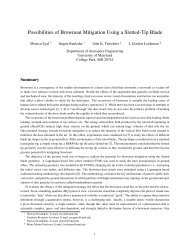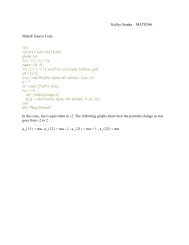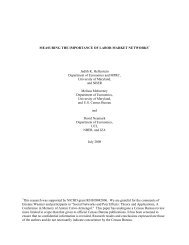Hydrophobicity at Small and Large Length Scales - TerpConnect ...
Hydrophobicity at Small and Large Length Scales - TerpConnect ...
Hydrophobicity at Small and Large Length Scales - TerpConnect ...
Create successful ePaper yourself
Turn your PDF publications into a flip-book with our unique Google optimized e-Paper software.
<strong>Hydrophobicity</strong> <strong>at</strong> <strong>Small</strong> <strong>and</strong> <strong>Large</strong> <strong>Length</strong> <strong>Scales</strong><br />
1<br />
Ka Lum 1 ,David Ch<strong>and</strong>ler 1 <strong>and</strong> John D. Weeks 1;2<br />
Department of Chemistry, University of California, Berkeley,<br />
CA 94720,<br />
2<br />
Institute for Physical Science <strong>and</strong> Technology <strong>and</strong><br />
Department of Chemistry,<br />
University of Maryl<strong>and</strong>, College Park, MD 20742.<br />
(March 8, 1999)<br />
We develop a unied <strong>and</strong> generally applicable theory of solv<strong>at</strong>ion of small <strong>and</strong> large apolar species<br />
in w<strong>at</strong>er. In the former, hydrogen bonding of w<strong>at</strong>er is hindered yet persists near the solutes. In the<br />
l<strong>at</strong>ter, hydrogen bonding is depleted, leading to drying of extended apolar surfaces, large forces of<br />
<strong>at</strong>traction, <strong>and</strong> hysteresis on mesoscopic length scales. The cross over occurs on nanometer length<br />
scales, when the local concentr<strong>at</strong>ion of apolar units is suciently high, or when an apolar surface is<br />
suciently large. Our theory for the cross over has implic<strong>at</strong>ions concerning the stability of protein<br />
assemblies <strong>and</strong> protein folding.<br />
Introduction<br />
It has long been accepted th<strong>at</strong> hydrophobic interactions<br />
| the eective <strong>at</strong>tractions between apolar groups<br />
in w<strong>at</strong>er | play a central role in the stability of mesoscopic<br />
assembly <strong>and</strong> biological structure in aqueous environments<br />
[1,2]. Yet, a quantit<strong>at</strong>ive underst<strong>and</strong>ing of<br />
this role has been elusive. One obstacle to this underst<strong>and</strong>ing<br />
is the multifaceted n<strong>at</strong>ure of hydrophobic interactions<br />
th<strong>at</strong> we focus upon in this paper. In particular,<br />
we show howhydrophobic interactions between small apolar<br />
groups <strong>at</strong> low concentr<strong>at</strong>ions in w<strong>at</strong>er are very different<br />
from those between large assemblies or rel<strong>at</strong>ively<br />
high concentr<strong>at</strong>ions of hydrophobic groups in w<strong>at</strong>er. The<br />
former is pertinent when considering, say, the aqueous<br />
solv<strong>at</strong>ion of a butane or butanol molecule. The l<strong>at</strong>ter is<br />
relevant to the solv<strong>at</strong>ion of macromolecules such as proteins.<br />
In this paper, we present a quantit<strong>at</strong>ive theory for<br />
these two regimes <strong>and</strong> show th<strong>at</strong> the cross over between<br />
them occurs on nanometer length scales.<br />
Figure (1) juxtaposes hydrophobicity on small <strong>and</strong><br />
large length scales. Hydrophobic units do not hydrogen<br />
bond to w<strong>at</strong>er <strong>and</strong> cre<strong>at</strong>e excluded volume regions where<br />
the density of w<strong>at</strong>er molecules vanishes. When these<br />
units are small enough, w<strong>at</strong>er can reorganize near them<br />
without sacricing hydrogen bonds. The entropic cost<br />
of this structural change leads to low solubility for small<br />
apolar species in w<strong>at</strong>er. The cost <strong>and</strong> corresponding solubility<br />
are readily understood <strong>and</strong> computed in terms<br />
of properties of homogeneous bulk w<strong>at</strong>er, such as its radial<br />
distribution function [3{6]. There is, however, no<br />
strong inducement for small numbers of small hydrophobic<br />
groups to associ<strong>at</strong>e in w<strong>at</strong>er. It is more likely th<strong>at</strong><br />
w<strong>at</strong>er will separ<strong>at</strong>e such species r<strong>at</strong>her than drive them<br />
together [4,6,7].<br />
On the other h<strong>and</strong>, close to a large hydrophobic object<br />
| perhaps an assembly of several apolar units possibly<br />
interspersed with a few hydrophilic units | the persistence<br />
of a hydrogen bond network is geometrically impossible.<br />
The resulting energetic eect can induce drying, as<br />
envisioned by Stillinger [3]. Further, this drying can lead<br />
to strong <strong>at</strong>tractions between large hydrophobic objects,<br />
as observed in surface force measurements [8]. For example,<br />
the loss of hydrogen bonds near the two extended<br />
hydrophobic surfaces depicted in Fig. (1b) causes w<strong>at</strong>er<br />
to move away from those surfaces, producing thin vapor<br />
layers. Fluctu<strong>at</strong>ions in the interfaces formed in this way<br />
can de-stabilize <strong>and</strong> expel the remaining liquid contained<br />
between these surfaces. The resulting pressure imbalance<br />
will cause the surfaces to <strong>at</strong>tract. If the liquid is close to<br />
coexistence with the vapor phase, as is the case for w<strong>at</strong>er<br />
<strong>at</strong> ambient conditions, this phenomenon occurs with<br />
widely separ<strong>at</strong>ed surfaces.<br />
For the geometry pictured in Fig. (1b), macroscopic<br />
consider<strong>at</strong>ions provide an estim<strong>at</strong>e of when the intersurface<br />
separ<strong>at</strong>ion, D, is suciently small for this destabiliz<strong>at</strong>ion<br />
to occur. The bounded liquid has an unfavorable<br />
surface energy proportional to the net surface area,<br />
where the surface tension, , is the constant ofproportionality.<br />
This energy is counteracted by the favorable<br />
bulk free energy proportional to the average number of<br />
molecules in the bounded liquid, where the proportionality<br />
constant is the dierence between liquid <strong>and</strong> gas<br />
chemical potential, ` , g . For large enough D, provided<br />
` , g < 0, the bulk energy domin<strong>at</strong>es over the<br />
surface energy, <strong>and</strong> the bounded liquid is stable. On the<br />
other h<strong>and</strong>, when D is less than the critical separ<strong>at</strong>ion<br />
2<br />
D c <br />
n` j` , g j ; (1)<br />
surface energy is dominant, <strong>and</strong> the bounded liquid is<br />
de-stabilized with respect to the vapor. Here, n` is the<br />
molecular density of the bulk liquid (the average number<br />
of molecules per unit volume). Accordingly, for w<strong>at</strong>er<br />
<strong>at</strong> room temper<strong>at</strong>ure <strong>and</strong> <strong>at</strong>mospheric pressure [9], D c <br />
1
100 nm. At this large length scale, the evapor<strong>at</strong>ion of w<strong>at</strong>er<br />
induced by drying surfaces would seem to be a generic<br />
<strong>and</strong> well understood phenomenon [10{12], <strong>and</strong> its pertinence<br />
to hydrophobicity <strong>at</strong> large length scales has not<br />
gone without <strong>at</strong>tention [13{16]. However, since drying<br />
is a non-linear phenomenon, its manifest<strong>at</strong>ion <strong>at</strong> large<br />
length scales is aected by small length scale structure.<br />
Self consistency between small <strong>and</strong> large length scale effects<br />
is missing in these earlier tre<strong>at</strong>ments.<br />
(b)<br />
(a)<br />
D>D c<br />
D
For the homogeneous uid, n(r) is simply the constant<br />
bulk density, n`. Excluded volume, however, cre<strong>at</strong>es<br />
gradients in the average density n(r) <strong>and</strong> in many<br />
cases can induce rapidly varying components analogous<br />
to the oscill<strong>at</strong>ions in the uid radial distribution function,<br />
manifesting molecular scale granularity ofthe liquid<br />
[25]. Since molecules in the liquid <strong>at</strong>tract one another<br />
with some nite range of interaction, , any such sp<strong>at</strong>ial<br />
vari<strong>at</strong>ion of n(r) must be accompanied by a gradient in<br />
the energy density eld arising from the <strong>at</strong>tractive intermolecular<br />
interactions. This produces a net force from<br />
the unbalanced <strong>at</strong>tractive interactions directed towards<br />
the region of higher density [26]. The <strong>at</strong>tractive energy<br />
density eld can be written as ,2an(r), where the overbar<br />
indic<strong>at</strong>es a normalized average or coarse graining of<br />
the uid density n(r) over the length scale , <strong>and</strong> ,n 2 a<br />
is the adhesive energy density of the homogeneous uid<br />
of density n [27]. We will see th<strong>at</strong> for w<strong>at</strong>er, 0.3 nm.<br />
Averaging over the length scale of <strong>at</strong>tractive interactions<br />
smooths out quickly varying oscill<strong>at</strong>ory components of<br />
n(r). Thus, the resulting n(r) is rel<strong>at</strong>ively slowly varying,<br />
even when n(r) itself might be rapidly varying. We<br />
call n(r) the coarse grained density <strong>and</strong> will exploit its<br />
rel<strong>at</strong>ively slowvari<strong>at</strong>ion in our calcul<strong>at</strong>ion of the full n(r).<br />
To th<strong>at</strong> end, let us rst recall the usual square gradient<br />
theory for a slowly varying free liquid-vapor interface<br />
[10,28]. This theory applies only when the density eld<br />
varies little over the length scale : In th<strong>at</strong> case, the<br />
st<strong>at</strong>istical weight for a given (r) in the gr<strong>and</strong> canonical<br />
ensemble is proportional to expf,F 0 [(r)]g , where<br />
F 0 [(r)] is the eective Hamiltonian or free energy functional<br />
Z<br />
F 0 [(r)] = dr<br />
w ((r)) + 1 <br />
2 mjr(r)j2 : (2)<br />
Here, ,1 = k B T is Boltzmann's constant times temper<strong>at</strong>ure,<br />
w((r)) = w((r);) is a local free energy density<br />
parameterized by the ambient chemical potential , <strong>and</strong><br />
m = a 2 [29]. [The subscript \0" indic<strong>at</strong>es the absence<br />
of any imposed excluded volume th<strong>at</strong> would induce rapid<br />
sp<strong>at</strong>ial vari<strong>at</strong>ion in (r).]<br />
In mean eld theory, the equilibrium n(r) = h(r)i<br />
is the function th<strong>at</strong> minimizes this free energy, i.e.,<br />
0 = F 0 =n(r). This condition yields the well known<br />
dierential equ<strong>at</strong>ion for n(r) [28]<br />
w 0 (n(r)) = mr 2 n(r)<br />
=2a[n(r) , n(r)] ; (3)<br />
where w 0 (n) = @w=@n. At phase equilibrium, where a<br />
liquid of homogeneous density n` coexists with a gas of<br />
homogeneous density n g , the conditions of constant pressure<br />
<strong>and</strong> chemical potential correspond to w(n`) =w(n g )<br />
<strong>and</strong> w 0 (n`) = w 0 (n g ) = 0; respectively <strong>and</strong> there exists<br />
a slowly varying solution to Eq. (3) describing the<br />
liquid-vapor interface. In the second line of Eq. (3), the<br />
Laplacian term has been rewritten in terms of the coarse<br />
grained density n(r); the expressions are equivalent by<br />
second order Taylor expansion of n(r 0 ) about n(r) inthe<br />
integr<strong>at</strong>ion th<strong>at</strong> denes the coarse grained density. [See,<br />
for example, Eq. (14) below.]<br />
In general, however, excluded volume regions or other<br />
perturb<strong>at</strong>ions can induce rapidly varying components in<br />
n(r) th<strong>at</strong> cannot be described by Eqs. (2) <strong>and</strong> (3). Nevertheless,<br />
even in such cases, the associ<strong>at</strong>ed coarse grained<br />
density, n(r), remains slowly varying. This observ<strong>at</strong>ion<br />
allows us to determine a slowly varying component ofthe<br />
full density [21]. The rapidly varying component will be<br />
tre<strong>at</strong>ed in a second step as discussed below <strong>and</strong> the selfconsistent<br />
combin<strong>at</strong>ion of both components will give an<br />
accur<strong>at</strong>e description of the full n(r).<br />
We denote the slowly varying component byn s (r) <strong>and</strong><br />
require th<strong>at</strong> it s<strong>at</strong>isfy Eq. (3) when the coarse grained<br />
density arising from the full n(r) is used:<br />
w 0 (n s (r)) = 2a[n(r) , n s (r)] : (4)<br />
The rel<strong>at</strong>ion to the usual free interface theory becomes<br />
clearer if we add <strong>and</strong> subtract the coarse grained density<br />
of the slowly varying component, n s (r), <strong>and</strong> exp<strong>and</strong> as<br />
before. This yields our nal result:<br />
w 0 (n s (r)) = mr 2 n s (r) +2a[n(r) , n s (r)] : (5)<br />
Equ<strong>at</strong>ion (5) is the general formula for a slowly varying<br />
density eld n s (r) in the presence of the (self consistent)<br />
potential, ,2a[n(r) , n s (r)]. This eld takes<br />
account of the extra unbalanced <strong>at</strong>tractive energy density<br />
arising from the rapidly varying component of the<br />
density, n(r) , n s (r). In general, n s (r) contains most<br />
of the long wavelength vari<strong>at</strong>ion of the full density, <strong>and</strong><br />
in the absence of rapid sp<strong>at</strong>ial vari<strong>at</strong>ion of the density,<br />
n(r) =n s (r):In th<strong>at</strong> case, Eq. (5) reduces to the st<strong>and</strong>ard<br />
theory for slowly varying inhomogeneous density<br />
elds, Eq. (3). The theory is altered, however, by the<br />
presence of rapidly varying components in n(r), such<br />
as those induced by excluded volume. The last term<br />
in Eq. (5) is then not negligible. This term permits<br />
interface-like solutions for n s (r) over a continuous range<br />
of temper<strong>at</strong>ure <strong>and</strong> density. Without it, sp<strong>at</strong>ially varying<br />
solutions exist only <strong>at</strong> liquid-gas coexistence, where w(n)<br />
has two equal minima loc<strong>at</strong>ed <strong>at</strong> the coexisting liquid <strong>and</strong><br />
gas densities.<br />
The small length scale dierences between n s (r) <strong>and</strong><br />
the full density eld n(r) are determined in a second step<br />
by averaging (r) =(r),n s (r), taking proper account<br />
of excluded volume regions. To the extent th<strong>at</strong> (r) is<br />
aGaussian r<strong>and</strong>om eld, the method for carrying out<br />
such an average is well known [5]. Moreover, Hummer<br />
et al. [6] have established th<strong>at</strong> small length scale density<br />
uctu<strong>at</strong>ions in w<strong>at</strong>er are indeed Gaussian. With such<br />
st<strong>at</strong>istics, we nd th<strong>at</strong> n(r) is given by<br />
3
n(r) =h(r)i v<br />
Z<br />
=n s (r), dr 0 c(r 0 )(r 0 ;r); (6)<br />
where angled brackets labeled with the subscript \v" indic<strong>at</strong>es<br />
the presence of the solute excluding solvent from<br />
the volume v. The function<br />
(r; r 0 )=h(r) (r 0 )i 0<br />
(7)<br />
is the variance for the Gaussian st<strong>at</strong>istics with a speci-<br />
ed n s (r), but in the absence of the solute (or any other<br />
source of inhomogeneities th<strong>at</strong> vary quickly in space).<br />
The function c(r) is nonzero only for r contained in the<br />
excluded volume v, <strong>and</strong> in th<strong>at</strong> region c(r) is determined<br />
by the requirement th<strong>at</strong> n(r) = 0 for all r in v [30].<br />
Equ<strong>at</strong>ion (6) is a generaliz<strong>at</strong>ion of Eq. (2.8) of Ref. [5].<br />
For the case of long length scale homogeneity, i.e., when<br />
n s (r) = n, Eq. (6) is the Pr<strong>at</strong>t-Ch<strong>and</strong>ler integral equ<strong>at</strong>ion<br />
for the distribution function of w<strong>at</strong>er surrounding<br />
an apolar solute [4]. This occurrence of homogeneity is<br />
obtained from Eq. (5) when the hydrophobic solute (i.e.,<br />
when the excluded volume) is rel<strong>at</strong>ively small.<br />
Equ<strong>at</strong>ions (5) <strong>and</strong> (6) provide a self consistent theory<br />
for w<strong>at</strong>er density near hydrophobic solutes [31]. In<br />
addition to this structural property, free energies of solv<strong>at</strong>ion<br />
are also of interest. For ideal hydrophobic units,<br />
i.e., species th<strong>at</strong> simply exclude w<strong>at</strong>er from specied volumes,<br />
solv<strong>at</strong>ion free energies are rel<strong>at</strong>ed to the probability<br />
of nding these volumes empty in the unperturbed<br />
uid [6]. Such a probability is a r<strong>at</strong>io of partition functions.<br />
Specically, the excess chemical potential for a<br />
hydrophobic object excluding the volume v is<br />
"<br />
#<br />
Z v (0)<br />
v = ,k B T ln P<br />
Z ; (8)<br />
N0 v(N)<br />
where Z v (N) is the partition function when N solvent<br />
molecules occupy the volume v. Using Gaussian st<strong>at</strong>istics<br />
to estim<strong>at</strong>e the probability, we nd th<strong>at</strong> this partition<br />
function is given by [32]<br />
(<br />
Z v (N) = exp<br />
where<br />
,F 0 [n s (r; N)]=k B T<br />
Z<br />
2<br />
)<br />
, N , dr n s (r;N)<br />
=2 v , (ln v )=2 ;<br />
Z<br />
v =<br />
v<br />
v<br />
(9)<br />
Z<br />
dr dr 0 (r; r 0 ) : (10)<br />
v<br />
In these rel<strong>at</strong>ionships, the integrals labeled with a subscript<br />
\v" are over the excluded volume v; <strong>and</strong> n s (r;N)<br />
is computed from Eq. (5), but Eq. (6) is replaced by<br />
n(r;N) =n s (r;N)<br />
Z Z<br />
, dr 0<br />
v<br />
v<br />
dr 00 [n s (r 0 ; N) , N=v] ,1<br />
v (r00 ; r) :<br />
(11)<br />
In the limit of small excluded volumes, Eq. (11) will<br />
predict a small unbalanced force, <strong>and</strong> the resulting<br />
n s (r; N) will be close to the bulk liquid density, n`: In<br />
th<strong>at</strong> case, Eqs. (9) <strong>and</strong> (10) reduce to the free energy of<br />
hydrophobic hydr<strong>at</strong>ion developed <strong>and</strong> used by Hummer<br />
et al. to successfully interpret the solv<strong>at</strong>ion of small apolar<br />
species in w<strong>at</strong>er [6,24]. In general, however, the main<br />
physical eect of the unbalanced <strong>at</strong>tractive forces taken<br />
into account in the rst step of our method is to reduce<br />
the density near the excluded volume region, thus permitting<br />
a lower solv<strong>at</strong>ion free energy.<br />
Applic<strong>at</strong>ions<br />
The theory presented above is a rel<strong>at</strong>ively general<br />
tre<strong>at</strong>ment of solv<strong>at</strong>ion excluded volume eects. To characterize<br />
the long wavelength properties of the w<strong>at</strong>er solvent<br />
determined in the rst step of our theory, wemust<br />
give a prescription for carrying out the coarse graining<br />
implied by the over-bars in Eq. (5) <strong>and</strong> values for w(n)<br />
<strong>and</strong> m. Since this step is essentially independent ofthe<br />
local structure, any reasonable form of these quantities<br />
is sucient provided it is t to the macroscopic properties<br />
of w<strong>at</strong>er over the thermodynamic range of interest.<br />
Therefore, we adopt the simplest possible van der Waals<br />
forms [28]<br />
bn<br />
w(n) =nk B T ln , an 2 , n: (12)<br />
1 , bn<br />
When the chemical potential is such th<strong>at</strong> liquid <strong>and</strong><br />
gas coexist,<br />
Z n` q<br />
= dn 2m[w(n) , w(n g )] (13)<br />
n g<br />
where n g <strong>and</strong> n` are the bulk gas <strong>and</strong> liquid densities, respectively,<br />
<strong>at</strong> the liquid-gas coexistence implied by w(n).<br />
We t the molecular volume parameter, b, <strong>and</strong> the energy<br />
density parameter, a, so th<strong>at</strong> i. n` has the value of the liquid<br />
w<strong>at</strong>er's density <strong>at</strong> phase coexistence when T = 298K;<br />
<strong>and</strong> ii. the compressibility implied by w(n) has the same<br />
value as th<strong>at</strong> for w<strong>at</strong>er <strong>at</strong> normal conditions. These conditions<br />
yield a 230 kJ cm 3 /mol 2 <strong>and</strong> b 15 cm 3 /mol.<br />
Then, with surface tension given by th<strong>at</strong> for liquid w<strong>at</strong>er<br />
<strong>at</strong> normal conditions, i.e., 72 mJ/m 2 18 k B T /nm 2 ,<br />
the second van der Waals rel<strong>at</strong>ion gives 2 m=a <br />
(0:38 nm) 2 . Finally, for the coarse graining prescription,<br />
we use a simple Gaussian weight:<br />
Z<br />
n(r) = dr 0 n(r 0 ) , 2 2 ,3=2<br />
exp(,jr , r 0 j 2 =2 2 ) :<br />
(14)<br />
4
The unique local structure of w<strong>at</strong>er enters explicitly in<br />
the second step of our theory through the specic<strong>at</strong>ion<br />
of (r; r 0 ) in Eq. (6). Here too we use experimental d<strong>at</strong>a,<br />
setting<br />
(r; r 0 ) ' n s (r) (r , r 0 )+n s (r)n s (r 0 )h(jr,r 0 j); (15)<br />
where h(jr , r 0 j) + 1 is the radial distribution function of<br />
liquid w<strong>at</strong>er <strong>at</strong> the bulk density n` [33]. Approxim<strong>at</strong>ion<br />
(15) becomes exact in the limit of homogeneity, n s (r) =<br />
n`, <strong>and</strong> in the limit of low density. It is well-dened <strong>at</strong><br />
intermedi<strong>at</strong>e densities <strong>and</strong> serves as a comput<strong>at</strong>ionally<br />
practical interpol<strong>at</strong>ion formula.<br />
Our choices for these quantities are r<strong>at</strong>her arbitrary,<br />
but still consistent with the most important physical aspects<br />
of hydrophobicity. For instance, to correctly predict<br />
the onset of drying, it is important th<strong>at</strong> the proximity<br />
of liquid-gas coexistence is accur<strong>at</strong>ely represented.<br />
To correctly estim<strong>at</strong>e (r; r 0 ) in the drying regime where<br />
density islow, it is also important th<strong>at</strong> this function is<br />
consistent with the exact low density form, n s (r) (r,r 0 ).<br />
When drying does not occur <strong>and</strong> short length scale effects<br />
domin<strong>at</strong>e, it is important th<strong>at</strong> (r; r 0 ) is consistent<br />
with the exact form for the homogeneous liquid,<br />
n`(r , r 0 )+n 2`h(jr,r0 j). All these fe<strong>at</strong>ures are captured<br />
by our choices, <strong>and</strong> other details have rel<strong>at</strong>ively<br />
small eects on numerical results derived from the theory.<br />
For example, in the applic<strong>at</strong>ions reported below, no<br />
qualit<strong>at</strong>ive changes are found on altering the value of <br />
by 20%, or on altering the coarse graining prescription,<br />
Eq. (14), to some other reasonable choices. An equ<strong>at</strong>ion<br />
of st<strong>at</strong>e more accur<strong>at</strong>e than (12) might help in making<br />
predictions over a wide range of temper<strong>at</strong>ures, but for<br />
the use we make of it here, Eq. (12) seems s<strong>at</strong>isfactory.<br />
With these ingredients in h<strong>and</strong>, we have carried out a<br />
series of calcul<strong>at</strong>ions to illustr<strong>at</strong>e the predictions of the<br />
self consistent structural Eqs. (5) <strong>and</strong> (6), <strong>and</strong> the corresponding<br />
free energy rel<strong>at</strong>ions (9) <strong>and</strong> (11).<br />
Hydr<strong>at</strong>ion of hard spheres<br />
Our rst applic<strong>at</strong>ion concerns the hydr<strong>at</strong>ion of a hard<br />
sphere excluding w<strong>at</strong>er from avolume of radius R centered<br />
<strong>at</strong> the origin. Figure (2) shows the excess chemical<br />
potential, v , as a function of R computed from the theory.<br />
In the eld of structural biology, it is often assumed<br />
th<strong>at</strong> hydrophobic solv<strong>at</strong>ion energies are proportional to<br />
exposed hydrophobic surface area [34{36]. As such, one<br />
might expect th<strong>at</strong> v would be proportional to R 2 . For<br />
R > 2 nm, the theory shows th<strong>at</strong> the r<strong>at</strong>io v=4R 2<br />
does reach an approxim<strong>at</strong>e pl<strong>at</strong>eau with a value similar<br />
to th<strong>at</strong> of the surface tension, . For smaller R, however,<br />
v =4R 2 is a rapidly varying function of R: This<br />
variability explains why there is no consensus over the<br />
appropri<strong>at</strong>e hydrophobic energy per unit area governing<br />
nanometer assemblies, such as protein structures. On a<br />
nanometer length scale, there is no unique value.<br />
∆µ v (kJ/mol)<br />
60<br />
50<br />
40<br />
30<br />
20<br />
10<br />
0<br />
∆µ v /(4πR 2 )(mJ/m 2 )<br />
160<br />
120<br />
80<br />
40<br />
0<br />
0 20 40 60 80<br />
R(Å)<br />
0 1 2 3 4<br />
R(Å)<br />
FIG. 2. Excess chemical potential for a hard sphere of<br />
radius R in w<strong>at</strong>er. The solid lines indic<strong>at</strong>e the results of<br />
Eqs. (5), (9) <strong>and</strong> (11). The circles are the results of computer<br />
simul<strong>at</strong>ions [6]. The dashed line is the result of the Gaussian<br />
model, namely Eq. (9) with n s(r) =n`[6]. The dotted line is<br />
a continuum theory estim<strong>at</strong>e (see text for description). The<br />
arrow indic<strong>at</strong>es the value for the surface tension of w<strong>at</strong>er.<br />
For small spheres (R < 0:4 nm), v has been estim<strong>at</strong>ed<br />
by computer simul<strong>at</strong>ion [37]. Figure (2) shows<br />
th<strong>at</strong> theory is in good accord with the simul<strong>at</strong>ion results.<br />
In this small sphere regime, the full theory also diers<br />
little from the predictions of simple Gaussian st<strong>at</strong>istics,<br />
namely Eq. (9) with n s (r;N) = n`. Gaussian st<strong>at</strong>istics<br />
is the basis for the Pr<strong>at</strong>t-Ch<strong>and</strong>ler theory of hydrophobicity<br />
[5], both in its traditional form [4], <strong>and</strong> its recent<br />
extension [6]. The agreement between theory <strong>and</strong> simul<strong>at</strong>ion<br />
in this regime is consistent with the successes of<br />
th<strong>at</strong> theory in predicting, for example, free energies of<br />
transfer <strong>and</strong> solubilities of small hydrophobic molecules.<br />
For R > 1 nm, however, the predictions of the Gaussian<br />
model diverge from those of the full theory. The divergence<br />
is due to drying. This phenomenon is predicted by<br />
the full theory, but it is outside the scope of the Gaussian<br />
model. In view of the disparity, itmay be inappropri<strong>at</strong>e<br />
to use the Gaussian model to interpret temper<strong>at</strong>ure <strong>and</strong><br />
pressure eects on the stability of protein structures [24].<br />
For large R; one might consider employing a simpli-<br />
ed continuum theory based upon Eq. (5), but replacing<br />
the self consistent eld term with boundary conditions<br />
n s (r;N) =N=v for r R <strong>and</strong> n s (r;N) =n`for R !1.<br />
In general, the n s (r;N) constructed in this way will vary<br />
rapidly near the surface of the volume v. This continuum<br />
theory is therefore not self consistent. Moreover,<br />
Eq. (5) shows th<strong>at</strong> the self consistent eld is non-zero<br />
outside the surface <strong>and</strong> cannot be represented by a single<br />
boundary condition. Indeed, the predictions of the<br />
5
continuum model are uns<strong>at</strong>isfactory in the physically interesting<br />
cross-over regime, as shown in Fig. (2).<br />
The solute-w<strong>at</strong>er radial distribution function, g(r +<br />
R) = n(r + R)=n`, as a function of the distance r + R<br />
from the center of an excluded volume region of radius R,<br />
directly illustr<strong>at</strong>es the n<strong>at</strong>ure of the drying phenomenon.<br />
This function is shown in Fig. (3). For small spheres,<br />
g(r +R) exhibits oscill<strong>at</strong>ions manifesting the microscopic<br />
granularity ofliquid w<strong>at</strong>er. For R > 1 nm, density depletion<br />
is evident, <strong>and</strong> the magnitude of the oscill<strong>at</strong>ions<br />
decreases. For large R, g(r + R) rises smoothly with increasing<br />
r. Evidently, a ball of oily groups with radius<br />
larger than 1 nm, e.g., a spherical cluster of about 20<br />
methyl groups, is large enough to induce drying. Signicantly<br />
smaller assemblies will not induce this eect.<br />
n s (r+R)/n l<br />
g(r+R)<br />
1.0<br />
0.0<br />
2.0<br />
1.0<br />
0.0<br />
R=4Å<br />
R=10Å<br />
R=4Å<br />
R=10Å<br />
g(R)<br />
R=88Å<br />
R=88Å<br />
3.0<br />
2.0<br />
1.0<br />
0.0<br />
R → ∞<br />
0 8 16<br />
0 2 4 6 8<br />
R(Å)<br />
R → ∞<br />
0 8 16 24<br />
r(Å)<br />
FIG. 3. Upper part: Slowly varying component n s(R + r)<br />
of the average w<strong>at</strong>er density as a function of the distance<br />
R + r from the center of excluded volume regions with<br />
varying radii R: Lower part: Radial distribution function<br />
g(R + r) n(R + r)=n` giving the net average w<strong>at</strong>er density<br />
around the same excluded volume regions. The inset graph<br />
focuses on the contact value of th<strong>at</strong> function. Solid lines are<br />
the results of Eqs. (5) <strong>and</strong> (6). Circles are the results of computer<br />
simul<strong>at</strong>ions [37]. The dashed line is from the Gaussian<br />
model, namely Eq. (6) with n s(r) =n`[4].<br />
The behavior of n(r) for w<strong>at</strong>er near a large hard sphere<br />
is thus much like th<strong>at</strong> for the liquid near a free liquidgas<br />
interface, as Stillinger envisioned long ago [3]. Stillinger<br />
also theorized th<strong>at</strong> the contact value, i.e., g(R);<br />
is a non-monotonic function of R. For small R; the removal<br />
of w<strong>at</strong>er within the excluded volume is accommod<strong>at</strong>ed<br />
by an increase in density adjacent to the volume.<br />
For small R; g(R) is therefore an increasing function of<br />
R. For large enough R; however, drying sets in, making<br />
g(R) a decreasing function of R. Stillinger made<br />
numerical predictions of this behavior, based upon an<br />
algebraic interpol<strong>at</strong>ion formula connecting two regimes<br />
of small <strong>and</strong> large hydrophobic spheres. His predictions<br />
agree qualit<strong>at</strong>ively with the results of our theory shown in<br />
Fig. (3). These theoretical results also agree reasonably<br />
well with computer simul<strong>at</strong>ion results, over the limited<br />
regime where these simul<strong>at</strong>ion results are available. Better<br />
agreement would probably require better estim<strong>at</strong>es of<br />
w(n) <strong>and</strong> (r; r 0 ) than those we have used as input for<br />
the calcul<strong>at</strong>ions.<br />
Hydr<strong>at</strong>ion of two parallel hard pl<strong>at</strong>es<br />
As discussed in the introduction, drying of extended<br />
hydrophobic surfaces can lead to strong <strong>at</strong>tractions between<br />
pairs of such surfaces. As a second applic<strong>at</strong>ion, we<br />
therefore consider the solvent induced interactions between<br />
a pair of two innite hard pl<strong>at</strong>es. The pl<strong>at</strong>es lie<br />
parallel to the x , y axis of a Cartesian coordin<strong>at</strong>e system,<br />
<strong>and</strong> they exclude w<strong>at</strong>er from the regions zD. With this arrangement, our calcul<strong>at</strong>ions provide<br />
an interpret<strong>at</strong>ion of surface force measurements. These<br />
experiments reveal long ranged forces between hydrophobic<br />
surfaces in w<strong>at</strong>er. While disagreeing over quantit<strong>at</strong>ive<br />
details [8], they show th<strong>at</strong> an <strong>at</strong>tractive force becomes<br />
measurable <strong>at</strong> large inter-surface separ<strong>at</strong>ion, in<br />
most cases up to tens of nanometers. Further, when<br />
brought to separ<strong>at</strong>ions of about 10 nm, two hydr<strong>at</strong>ed<br />
parallel hydrophobic pl<strong>at</strong>es will jump into contact. Hysteresis<br />
is observed in the inward- <strong>and</strong> the outward-going<br />
measurements, indic<strong>at</strong>ive of a kinetically frustr<strong>at</strong>ed rst<br />
order phase transition.<br />
Hysteresis is predicted by our analysis in th<strong>at</strong> over a<br />
range of D values, there are two solutions to Eq. (5) <strong>and</strong><br />
thus two dierent free energies. The resulting free energy<br />
branches as a functions of D are shown in Fig. (4). In<br />
agreement with the elementary estim<strong>at</strong>e, Eq. (1), the gure<br />
shows th<strong>at</strong> even for rel<strong>at</strong>ively large interpl<strong>at</strong>e separ<strong>at</strong>ions,<br />
the conned liquid w<strong>at</strong>er is less thermodynamically<br />
stable than its vapor. The liquid remains metastable over<br />
a wide range of D. In this regime, the kinetic p<strong>at</strong>hway<br />
to evapor<strong>at</strong>ion involves uctu<strong>at</strong>ions of the w<strong>at</strong>er interfaces<br />
sucient to cre<strong>at</strong>e a vapor bridge between the two<br />
pl<strong>at</strong>es [16,38]. Such large uctu<strong>at</strong>ions occur only rarely.<br />
To a good approxim<strong>at</strong>ion, w<strong>at</strong>er will remain between the<br />
pl<strong>at</strong>es until D is made so small th<strong>at</strong> the conned liquid<br />
becomes mechanically unstable. Figure (4) shows th<strong>at</strong><br />
this limit of metastability (i.e., the spinodal) of conned<br />
w<strong>at</strong>er is reached when D 5 nm. This length is comparable<br />
to the distance where hydr<strong>at</strong>ed hydrophobic surfaces<br />
jump into contact in surface force experiments. According<br />
to our theory, this jump distance will decrease as the<br />
bulk liquid moves away from phase coexistence, for ex-<br />
6
ample, by decreasing temper<strong>at</strong>ure or adding salt to the<br />
liquid. Further, the jump distance will increase with the<br />
addition of kinetic p<strong>at</strong>hways to evapor<strong>at</strong>ion, such as the<br />
presence of gas bubbles in the solvent.<br />
40<br />
D<br />
D<br />
2R<br />
20<br />
∆µ v<br />
/ Area (mJ/m 2 )<br />
0.0<br />
−40.0<br />
−80.0<br />
−120.0<br />
∆µ (D) (kJ/mol/Å)<br />
v<br />
0<br />
0<br />
0<br />
0<br />
-20<br />
-40<br />
~<br />
~<br />
~<br />
~<br />
~<br />
~<br />
R=5Å<br />
6Å<br />
7Å<br />
9Å<br />
0 10 20 30<br />
D (Å)<br />
−160.0<br />
1 10 100 1000 10000<br />
D (Å)<br />
FIG. 4. Free energy per unit surface area for w<strong>at</strong>er con-<br />
ned between two parallel hard surfaces separ<strong>at</strong>ed a distance<br />
D. The zero of free energy is taken as the D !1limiting<br />
value. The curves are computed from Eqs. (5), (9) <strong>and</strong> (11),<br />
with N =0. Solid lines refer to stable branches, dashed lines<br />
refer to metastable branches, <strong>and</strong> the dotted line shows the<br />
small D limit of stability for the liquid density phase.<br />
Since mean eld theory is used to describe large length<br />
scale structure, capillary waves are not included in our<br />
tre<strong>at</strong>ment. These small amplitude interfacial uctu<strong>at</strong>ions<br />
adjacent to each pl<strong>at</strong>e surface give rise to weak long range<br />
interpl<strong>at</strong>e <strong>at</strong>tractions. A complete theory for large distance<br />
<strong>at</strong>tractions between extended hydrophobic surfaces<br />
must account for this capillary wave eect. Such long<br />
ranged forces, however, are rel<strong>at</strong>ively small in comparison<br />
with the those produced by drying <strong>and</strong> evapor<strong>at</strong>ion.<br />
Hydr<strong>at</strong>ion of parallel cylinders<br />
An array of four parallel cylinders provides another<br />
instructive applic<strong>at</strong>ion, evoc<strong>at</strong>ive of helix bundle motifs<br />
common in protein structures [39]. Specically, we<br />
have carried out calcul<strong>at</strong>ions of w<strong>at</strong>er densities <strong>and</strong> free<br />
energies in the presence of four innite cylinders, each<br />
of radius R, where the axis of each cylinder is parallel<br />
to the z axis of a Cartesian coordin<strong>at</strong>e system.<br />
These axes form a square in the x , y plane with side<br />
length D +2R. Thus, w<strong>at</strong>er is expelled from the regions<br />
[x (R + D=2)] 2 +[y(R+D=2)] 2 0:6 nm, there is a range of D<br />
values where metastable high density st<strong>at</strong>es are found.<br />
For smaller cylinders, there is no such metastability. For<br />
all cases illustr<strong>at</strong>ed, the low density phase is stable for<br />
D < 1 nm, <strong>and</strong> the stability or metastability of this<br />
phase cre<strong>at</strong>es a powerful force favoring the assembly of<br />
the four cylinders. For R > 0:7 nm, the free energy<br />
barrier to associ<strong>at</strong>ion disappears, even in the metastable<br />
branch. For this regime, one therefore expects both powerful<br />
<strong>and</strong> rel<strong>at</strong>ively rapid associ<strong>at</strong>ion of the hydrophobic<br />
units. Conversion to net free energies requires multiplic<strong>at</strong>ion<br />
of v per unit length by the actual length for the<br />
cylinders. Thus, fe<strong>at</strong>ures illustr<strong>at</strong>ed in Fig. (5) reveal net<br />
free energetic eects th<strong>at</strong> can be very large compared to<br />
k B T .<br />
Figure (5) projects onto only one coordin<strong>at</strong>e, D. The<br />
absence of a free energy barrier to associ<strong>at</strong>ion in th<strong>at</strong> direction<br />
does not necessarily imply the actual p<strong>at</strong>hway to<br />
associ<strong>at</strong>ion is barrier free. The actual p<strong>at</strong>hway can have<br />
dynamical bottlenecks involving w<strong>at</strong>er density uctu<strong>at</strong>ions<br />
such as described above for the case of two parallel<br />
pl<strong>at</strong>es.<br />
7
For all cylinders considered in Fig. (5), mean eld theory<br />
predicts the low density phase remains metastable<br />
for D > 10 nm. In this phase, the four cylinders are encapsul<strong>at</strong>ed<br />
by avapor bubble of similar shape. Density<br />
uctu<strong>at</strong>ions, i.e., thermal excursions of the liquid-vapor<br />
interface, will break the bubble <strong>at</strong> values of D smaller<br />
th<strong>at</strong> those of the mean eld stability limits.<br />
∆µ (D) (kJ/mol/Å)<br />
v<br />
40<br />
20<br />
0<br />
0<br />
0<br />
0<br />
-20<br />
-40<br />
~<br />
~<br />
~<br />
~<br />
~<br />
~<br />
R= 6Å<br />
7Å<br />
8Å<br />
9Å<br />
0 10 20<br />
D(Å)<br />
FIG. 6. Free energies per unit length for w<strong>at</strong>er interacting<br />
with four parallel hard cylinders with hydrophilic outer<br />
sides. The parallel cylinders are depicted <strong>at</strong> the top of the<br />
gure, the shaded area denotes the hydrophilic regions. The<br />
distance of closest approach between cylinders is taken as<br />
D = ,0:27 nm. The zero of free energy is taken as the<br />
D !1limiting value. Curves are computed from Eqs. (9),<br />
(11), <strong>and</strong> Eq. (5) modied by subtracting the eld (r) from<br />
its right-h<strong>and</strong>-side. Solid lines refer to stable branches, the<br />
dashed line refers to the metastable branch, the dotted line<br />
refers to small D limit of stability for the high density solutions.<br />
The limits of stability of the low density solution are<br />
o the scale of this gure.<br />
Surfaces of helices assembling in actual protein structures<br />
are not entirely hydrophobic. The trends illustr<strong>at</strong>ed<br />
in Fig. (5), however, depend mostly on the fact th<strong>at</strong> the<br />
interior surfaces of the assembled bundle are hydrophobic.<br />
To show this fact, we have considered modied<br />
parallel cylinders, where the outer halves of the cylinders<br />
are hydrophilic, as illustr<strong>at</strong>ed in the upper part of<br />
Fig. (6). In particular, we have carried out calcul<strong>at</strong>ions<br />
with Eq. (5) modied by subtracting an <strong>at</strong>tractive interaction<br />
(r) from its right-h<strong>and</strong>-side, where<br />
Z<br />
(r) =,2an` dr 0 (r 0 ) , 2 2 ,3=2<br />
exp(,jr , r 0 j 2 =2 2 )<br />
D<br />
D<br />
2R<br />
(16)<br />
<strong>and</strong> (r) is unity for r 2 v 0 <strong>and</strong> zero otherwise. Here, v 0<br />
refers to a hydrophilic shell th<strong>at</strong> co<strong>at</strong>s the outer half surface<br />
of each cylinder <strong>and</strong> extends 0.3 nm within. Other<br />
choices for the strength <strong>and</strong> functional form of this potential<br />
eld are possible. The basic idea is to cre<strong>at</strong>e a<br />
w<strong>at</strong>er-like region within the solute. With Eq. (16), it is<br />
as if alayer of w<strong>at</strong>er molecules of density n` lies inside<br />
the outer-half surface of each cylinder.<br />
Results obtained with this modic<strong>at</strong>ion of Eq. (5) are<br />
plotted in Fig. (6). While details dier, the trends obtained<br />
for fully hydrophobic cylinders are indeed similar<br />
to those obtained with partially hydrophobic cylinders.<br />
For example, the size of free energy barriers are larger in<br />
the l<strong>at</strong>ter than in the former, <strong>and</strong> the radius required for<br />
high density metastable branches to appear is larger in<br />
the l<strong>at</strong>ter than in the former.<br />
Implic<strong>at</strong>ions<br />
Mesoscopic structures are stabilized by a variety of<br />
forces. To the extent th<strong>at</strong> hydrophobic forces are signicant,<br />
this paper illumin<strong>at</strong>es a number of important<br />
facts. First <strong>and</strong> foremost, hydrophobic eects of the type<br />
th<strong>at</strong> separ<strong>at</strong>e oily groups from aqueous solution appear<br />
only when local concentr<strong>at</strong>ions of hydrophobic units are<br />
large enough or extended enough to induce drying. Excess<br />
chemical potentials <strong>and</strong> transfer free energies of single<br />
small apolar species, like alkane chains of moder<strong>at</strong>e<br />
length, reveal nothing of the powerful interactions cre<strong>at</strong>ed<br />
by drying. Similarly, the structure of w<strong>at</strong>er near<br />
small apolar species provides little or no hint of the phenomenon<br />
th<strong>at</strong> inevitably domin<strong>at</strong>es for larger hydrophobic<br />
assemblies.<br />
Even in the presence of hydrophilic surfaces, powerful<br />
hyrophobic forces of assembly can arise from drying<br />
transitions. To the extent th<strong>at</strong> these forces are relevant<br />
to biological assembly, one can anticip<strong>at</strong>e general trends<br />
aecting the stability of such structures. Specically,<br />
changes in solvent th<strong>at</strong> move the bulk liquid away from<br />
liquid-gas phase coexistence (e.g., adding salt, increasing<br />
pressure, lowering temper<strong>at</strong>ure) will shorten the range<br />
<strong>and</strong> weaken these forces of assembly.<br />
Since powerful hydrophobic interactions require the<br />
onset of a phase transition, the dynamics of assemblies<br />
stabilized by this interaction will depend, <strong>at</strong> least in part,<br />
on the dynamics of the phase transition. Thus, for example,<br />
aspects of w<strong>at</strong>er structure <strong>and</strong> drying may play<br />
a signicant role in the kinetic p<strong>at</strong>hways to protein folding<br />
for transitions between congur<strong>at</strong>ions of diering hydrophobic<br />
stabiliz<strong>at</strong>ion. This possibility would explain<br />
directions of trends observed in the binding-unbinding<br />
kinetics of helix pairs in Rop [40]. Indeed, the evapor<strong>at</strong>ion<br />
kinetics of w<strong>at</strong>er conned by hydrophobic surfaces<br />
is signicantly slowed by adding alow concentr<strong>at</strong>ion of<br />
hydrophilic spots to the surfaces [41] since w<strong>at</strong>er interfaces<br />
are pinned <strong>at</strong> these spots. Most st<strong>and</strong>ard models<br />
8
of protein folding include w<strong>at</strong>er only implicitly, through<br />
its eect on free energy surfaces, <strong>and</strong> assume th<strong>at</strong> w<strong>at</strong>er<br />
is continually <strong>at</strong> equilibrium with the assembling solutes.<br />
We believe th<strong>at</strong> w<strong>at</strong>er plays a more explicit role in the<br />
dynamics than can be captured with such implicit equilibrium<br />
models.<br />
Drying is a collective phenomenon. As such, pair potentials<br />
of mean force between small apolar units are insucient<br />
for characterizing its onset. The onset or crossover<br />
to drying is found <strong>at</strong> the nanometer regime, the<br />
length scale of pertinence to protein assembly. In this<br />
regime, the phenomenon is too complex to be characterized<br />
by a single microscopic parameter, such as exposed<br />
surface area. It seems likely, therefore, th<strong>at</strong> most models<br />
used thus far in theoretical studies of protein structure<br />
oversimplify the true n<strong>at</strong>ure of the hydrophobic interactions<br />
conceived of long ago by Kauzmann. In contrast,<br />
the equ<strong>at</strong>ions written in this paper could be used to provide<br />
a comput<strong>at</strong>ionally convenient yet accur<strong>at</strong>e means to<br />
describe this n<strong>at</strong>ure.<br />
Acknowledgments<br />
We are gr<strong>at</strong>eful to Lawrence Pr<strong>at</strong>t, Gerhard Hummer<br />
<strong>and</strong> their coworkers for many helpful discussions <strong>and</strong> inform<strong>at</strong>ive<br />
preprints about their work on hydrophobicity,<br />
to Martin Karplus for telling us about Ref. [40], <strong>and</strong> to<br />
Kirill K<strong>at</strong>sov for helpful discussions about the present<br />
formalism. This research has been supported by grants<br />
from the N<strong>at</strong>ional Science Found<strong>at</strong>ion (CHE9508336 <strong>and</strong><br />
CHE9528915).<br />
[1] W. Kauzmann, Adv. Protein Chem. 14, 1 (1959).<br />
[2] C. Tanford, The Hydrophobic Eect{Form<strong>at</strong>ion of Micelles<br />
<strong>and</strong> Biological Membranes (Wiley-Interscience,<br />
New York, 1973)<br />
[3] F. H. Stillinger, J. Soln. Chem. 2, 141 (1973).<br />
[4] L. R. Pr<strong>at</strong>t <strong>and</strong> D. Ch<strong>and</strong>ler, J. Chem. Phys. 67, 3683<br />
(1977).<br />
[5] D. Ch<strong>and</strong>ler, Phys. Rev. E 48, 2898 (1993).<br />
[6] G. Hummer, S. Garde, A. E. Garca, A. Pohorille, <strong>and</strong><br />
L. R. Pr<strong>at</strong>t, Proc. N<strong>at</strong>l. Acad. Sci. USA 93, 8951 (1996)<br />
[7] C. S. Pangali, M. Rao, <strong>and</strong> B. J. Berne, J. Chem. Phys.<br />
70, 2975 (1979).<br />
[8] R. M. Pashley, P. M. McGuiggan, B. W. Ninham <strong>and</strong><br />
D. F. Evans, Science 229, 1088 (1985); H. K. Christenson<br />
<strong>and</strong> P. M. Claesson, Science 239, 390 (1988); Y.-H.<br />
Tsao, S. X. Yang, D. F. Evans, <strong>and</strong> Hakan Wennerstrom,<br />
Langmuir 7, 3154 (1991); H. K. Christenson, in Modern<br />
Approaches to Wettability: Theory <strong>and</strong> Applic<strong>at</strong>ions,<br />
edited by M. E. Schrader <strong>and</strong> G. Loeb (Plenum, New<br />
York, 1992); J. L. Parker, P. M. Claesson, <strong>and</strong> P. Attard,<br />
J. Phys. Chem. 98, 8468 (1994).<br />
[9] For w<strong>at</strong>er <strong>at</strong> st<strong>and</strong>ard conditions of 1 <strong>at</strong>m. <strong>and</strong> T =<br />
298 K, n` ' 0:055 mol/cm 3 ; ' 72 mJ/m 2 , <strong>and</strong><br />
` , g ',p=n` ',1:8 J/mol, where p denotes pressure.<br />
Surface tensions for oil-w<strong>at</strong>er interfaces dier only<br />
slightly from w<strong>at</strong>er-vapor surface tension. The l<strong>at</strong>ter is<br />
used here. Adopting an oil-w<strong>at</strong>er surface tension to estim<strong>at</strong>e<br />
D c would give a similarly large critical inter-surface<br />
separ<strong>at</strong>ion. The large value of D c is primarily a result of<br />
the close proximity ofphase coexistence (i.e., the rel<strong>at</strong>ively<br />
small magnitude of ` , g).<br />
[10] K. Binder <strong>and</strong> P. C. Hohenberg, Phys. Rev. B 6, 3461<br />
(1972).<br />
[11] E. Brezin, B. I. Halperin, <strong>and</strong> S. Leibler, J. Physique 44,<br />
775 (1983).<br />
[12] A. O. Parry <strong>and</strong> R. Evans, Physica A 181, 250 (1992).<br />
[13] G. Gompper, M. Hauser, <strong>and</strong> A. A. Kornyshev, J. Chem.<br />
Phys. 101, 3378 (1994).<br />
[14] D. Berard, P. Attard, <strong>and</strong> G. N. P<strong>at</strong>ey, J. Chem. Phys.<br />
98, 7236 (1993).<br />
[15] J. Forsman, B. Jonsson, C. E. Woodward <strong>and</strong> Hakan<br />
Wennerstrom, J. Phys. Chem. 101, 4253 (1997).<br />
[16] K. Lum <strong>and</strong> A. Luzar, Phys. Rev. E 56, R6283, (1997).<br />
[17] C. Y. Lee, J. A. McCammon <strong>and</strong> P. J. Rossky, J. Chem.<br />
Phys 80, 4448 (1984).<br />
[18] A. Wallqvist <strong>and</strong> B. J. Berne, Chem. Phys. Lett. 145, 26<br />
(1988).<br />
[19] A. Luzar, D. Br<strong>at</strong>ko <strong>and</strong> L. Blum, J. Chem. Phys 86,<br />
2955 (1987).<br />
[20] A. Wallqvist <strong>and</strong> B. J. Berne, J. Phys. Chem. 99, 2893<br />
(1995).<br />
[21] J. D. Weeks, K. K<strong>at</strong>sov, <strong>and</strong> K. Vollmayr, Phys. Rev.<br />
Lett. 81, 4400 (1998).<br />
[22] L. R. Pr<strong>at</strong>t <strong>and</strong> D. Ch<strong>and</strong>ler, J. Chem. Phys. 73, 3434<br />
(1980).<br />
[23] D. Ch<strong>and</strong>ler, J. D. Weeks, <strong>and</strong> H. C. Andersen, Science<br />
220, 787 (1983).<br />
[24] S. Garde, G. Hummer, A. E. Garca, M. E. Paulaitis,<br />
<strong>and</strong> L. R. Pr<strong>at</strong>t, Phys. Rev. Lett., 77, 4966 (1996); G.<br />
Hummer, S. Garde, A. E. Garca, M. E. Paulaitis, <strong>and</strong><br />
L. R. Pr<strong>at</strong>t, Proc. N<strong>at</strong>l. Acad. Sci. USA 95, 1552 (1998);<br />
G. Hummer, et al., J. Phys. Chem. B 102, 10469 (1998).<br />
[25] J. P. Hansen <strong>and</strong> I. R. McDonald, Theory of Simple Liquids<br />
(Academic, London, 1986).<br />
[26] J. D. Weeks, R. L. B. Selinger, <strong>and</strong> J. Q. Broughton,<br />
Phys. Rev. Lett. 75, 2694 (1995).<br />
[27] In the special case of the simple van der Waals uid,<br />
where the <strong>at</strong>tractive forces arise from a rel<strong>at</strong>ively long<br />
ranged pair potential u 1(r), the inhomogeneous energy<br />
density <strong>at</strong> position r is R dr 0 u 1(jr , r 0 j)n(r 0 )=,2an(r).<br />
In this case, a = , R dr u 1(r)=2 is the usual van der<br />
Waals <strong>at</strong>tractive force parameter. See Refs. [28,23].<br />
[28] J. S. Rowlinson <strong>and</strong> B. Widom, Molecular Theory of Capillarity<br />
(Clarendon Press, Oxford, 1982).<br />
[29] In the special case of the simple van der Waals<br />
uid with pair potential u 1(r); m=a = 2 =<br />
R<br />
dr r 2 u 1(r)=3 R dr u 1(r). See, for example, Ref. [28].<br />
[30] Anumerical solution can be found by adjusting c(r) (perhaps<br />
by adjusting its coecients in a basis set represent<strong>at</strong>ion)<br />
until n(r) =0 for r 2 v is s<strong>at</strong>ised to within desired<br />
accuracy.<br />
[31] One may make an initial guess for n s(r), perhaps n s(r) =<br />
n`, <strong>and</strong> solve Eq. (6) with this guess. The resulting n(r)<br />
9
can then used to solve the dierential Eq. (5) for n s(r);<br />
perhaps through a discrete expansion on a sp<strong>at</strong>ial grid.<br />
The n s(r) so obtained can then be inserted back into<br />
Eq. (6) to obtain a rened estim<strong>at</strong>e of n(r). The cycle<br />
can thus be repe<strong>at</strong>ed over <strong>and</strong> over, iter<strong>at</strong>ing until convergence<br />
is obtained.<br />
[32] This formula omits some additional terms involving integrals<br />
of the potential ,2a[n(r) , n s(r)] th<strong>at</strong> are small<br />
both in the limit of very small <strong>and</strong> very large excluded<br />
volume regions.<br />
[33] A. H. Narten <strong>and</strong> D. Levy, J. Chem. Phys. 55, 2263<br />
(1971).<br />
[34] D. Eisenberg <strong>and</strong> A. D. McLachlan, N<strong>at</strong>ure 319, 199<br />
(1986).<br />
[35] A. H. Juer, F. Eisenhaber, S. J. Hubbard, D. Walther,<br />
<strong>and</strong> P. Argos, Protein Sci. 4, 2499 (1995).<br />
[36] B. Vallone, A. E. Miele, P. Vecchini, E. Chiancone, <strong>and</strong><br />
M. Brunori, Proc. N<strong>at</strong>l. Acad. Sci. USA 95, 6103 (1998).<br />
[37] L. R. Pr<strong>at</strong>t <strong>and</strong> A. Pohorille, Proc. N<strong>at</strong>l. Acad. Sci. USA<br />
89, 2995 (1992).<br />
[38] K. Lum <strong>and</strong> D. Ch<strong>and</strong>ler, Intern. J. Thermal Phys. 19,<br />
845 (1998).<br />
[39] C. Br<strong>and</strong>en <strong>and</strong> J. Tooze, Introduction to Protein Structure<br />
(Garl<strong>and</strong> Publishing, New York, 1991).<br />
[40] M. Munson, K. S. Anderson <strong>and</strong> L. Regan, Folding &<br />
Design 2, 77 (1997).<br />
[41] K. Lum, Ph. D. Thesis, University of California, Berkeley,<br />
1998.<br />
10


